Key takeaways:
- Tantrums serve as a child’s way of communicating unexpressed emotions, often triggered by fatigue, hunger, or sensory overload.
- The importance of emotional validation and acknowledging a child’s feelings can significantly improve parent-child relationships.
- Practicing calmness, setting clear expectations, and using distraction are effective strategies for managing tantrums.
- Teaching emotional resilience involves guiding children through their challenges and modeling healthy emotional expression.
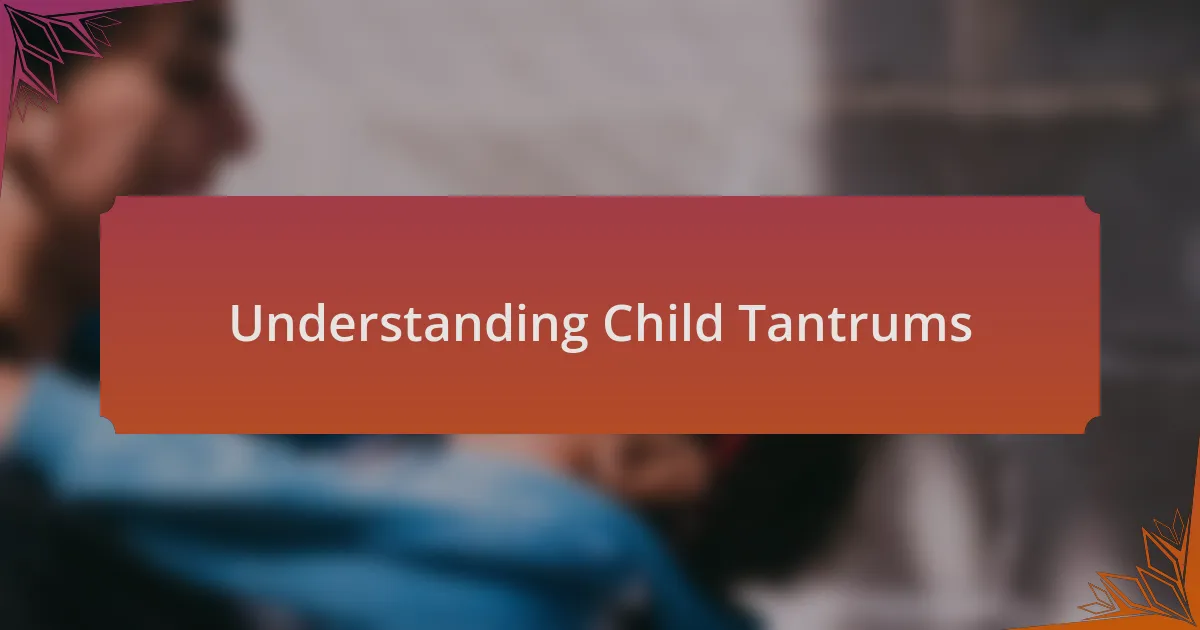
Understanding Child Tantrums
Understanding child tantrums can be quite a journey. I remember the first time my child threw a tantrum in a grocery store—carts piled high, people staring, and my heart racing. It struck me then that tantrums aren’t just expressions of frustration; they are often a child’s way of communicating feelings they can’t fully articulate.
I’ve come to realize that these outbursts can stem from a variety of emotions, whether it’s confusion, fear, or even just being too tired after a long day. Have you ever noticed how a simple change in routine can trigger a meltdown? I’ve learned that as parents, our response can either intensify or soothe the storm. When I’ve taken a moment to acknowledge my child’s feelings rather than dismiss them, the atmosphere usually shifts for the better.
Moreover, understanding the triggers behind these emotional eruptions has been enlightening. I’ve found that when my child is hungry or overwhelmed, the chances of a tantrum skyrocket. Recognizing these signals has not only eased our daily interactions but also allowed me to approach parenting with patience and empathy. It makes me wonder—how might our responses shape their emotional development over time?
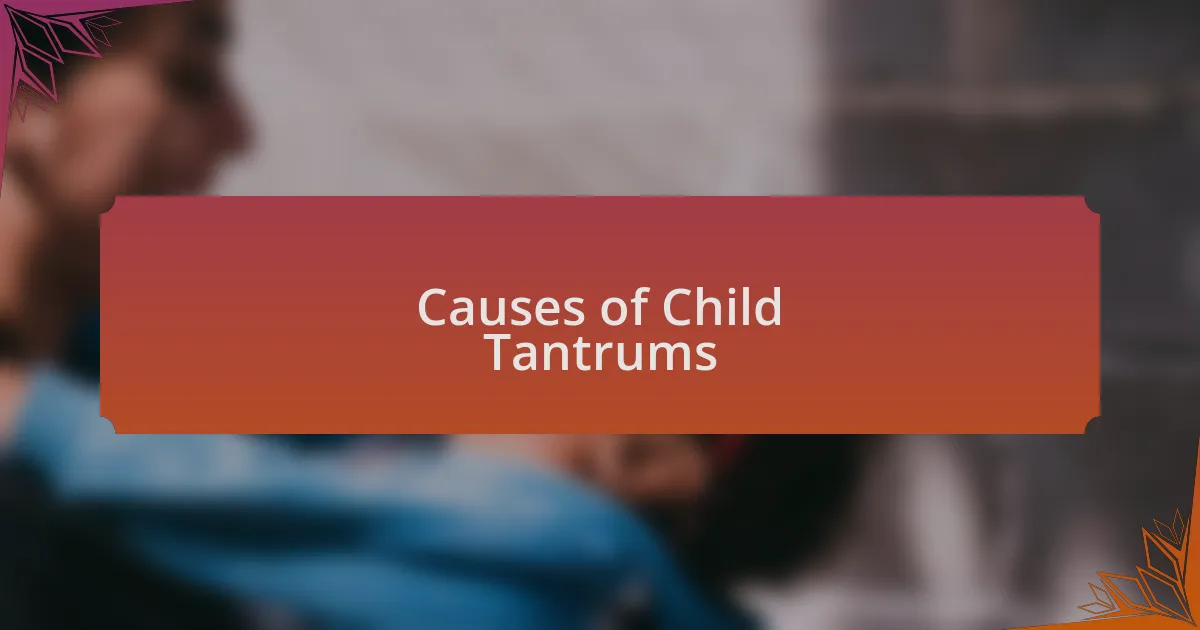
Causes of Child Tantrums
When it comes to the causes of child tantrums, I’ve often found that fatigue plays a significant role. I recall one afternoon when my child had skipped their nap; as we headed to a playdate, the mood shifted swiftly from excitement to meltdown. It was almost like a switch flipped, and it reminded me of how even adults can snap when we’re overtired. Have you noticed similar patterns in your child’s behavior?
Hunger, too, can be a hidden trigger. I’ve been caught off guard more than once when we suddenly went from laughter to tears simply because mealtime was delayed. It strikes me that our little ones don’t yet possess the vocabulary to say, “I’m hungry,” which can lead to some unexpected emotional outbursts. Now, I try to keep snacks on hand; it’s a small adjustment that has made a world of difference during outings.
Finally, emotional overwhelm is another significant cause. I remember a day at the park when my child was visibly distressed by the sounds and crowds, leading to a tantrum. It hit me then how sensory overload might create intense feelings they can’t process. Have you considered how environmental factors can impact your child’s mood? Recognizing these moments has taught me to offer a comforting presence rather than simply reacting to the meltdown. By paying attention to their environment, I can help them navigate these overwhelming experiences more gracefully.
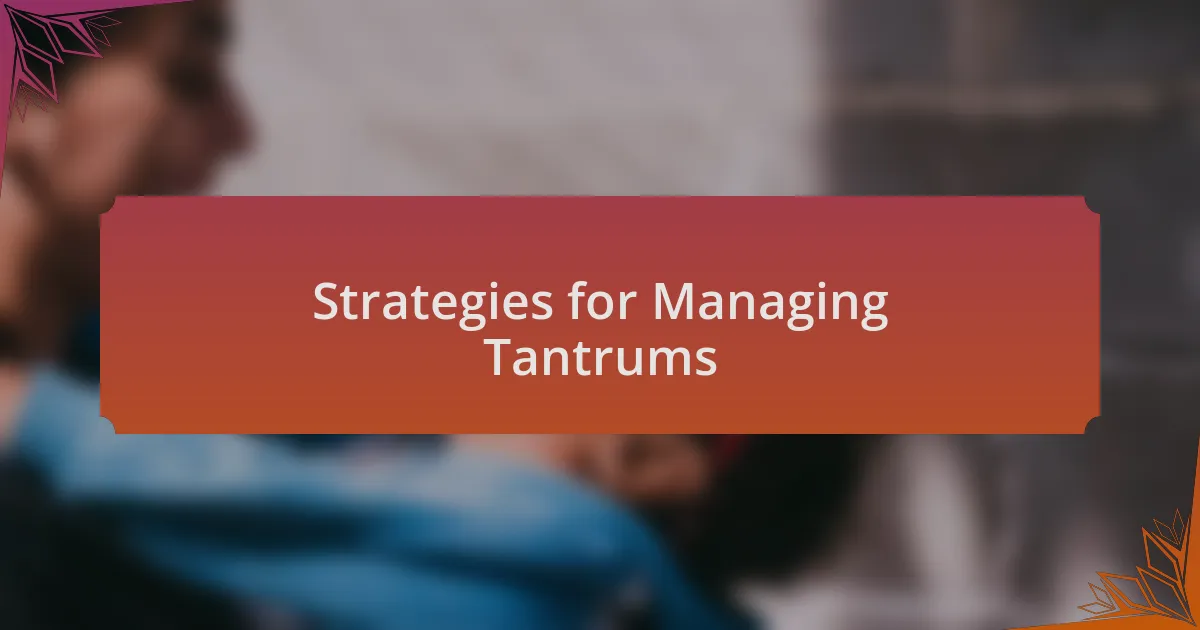
Strategies for Managing Tantrums
I’ve discovered that staying calm during a tantrum is crucial. There was a moment when my child’s frustrations erupted in the grocery store over a toy they desperately wanted. Instead of reacting with irritation, I took a deep breath and spoke softly. My calm presence seemed to diffuse the situation, reminding me that how we respond can significantly influence our children’s emotions.
Another effective strategy has been setting clear expectations beforehand. I recall a time we were about to go on a long car ride. I explained that it would be a while before we reached our destination and brought along their favorite toys and snacks. Sharing that information allowed my child to prepare mentally, which significantly reduced the chances of meltdown during the ride. Have you tried discussing potential challenges with your child before they happen?
Lastly, distraction often works wonders. I remember when we faced a tantrum at a family gathering. Instead of letting it escalate, I quickly redirected my child’s attention to a fun game we could play together, like spotting different colors in the room. This shift not only halted the tantrum but also created a new, joyful moment that we could share. It’s fascinating how a simple redirection can turn an anxious situation into laughter. What strategies have you found helpful in similar situations?
Lessons from My Child’s Tantrums
Experiencing my child’s tantrums has taught me about the importance of emotional validation. I once watched my little one dissolve into tears over a spilled drink, and rather than dismissing their feelings, I crouched down to their level and acknowledged their frustration. In that moment, I realized that acknowledging their emotions not only helped them feel understood but also made it easier to guide them towards calming down. How often do we forget to simply validate our kids’ feelings amid the chaos?
Another lesson emerged about setting realistic expectations. I vividly remember a family picnic where my child expected to enjoy the day without a hitch. When small setbacks occurred, such as a bug flying into their food, I could see the disappointment turn into a tantrum. It became clear to me that sometimes, preparing them for the fact that not everything will go perfectly can ease the transitions they struggle with. How can we equip ourselves and our children to embrace imperfections in life?
I’ve also learned that tantrums offer a golden opportunity for connection. One evening, after a particularly challenging day, my child unleashed a wave of anger over bedtime. Instead of rushing to enforce the routine, I sat beside them on the floor and simply listened. By sharing my own feelings about having a tough day, I felt a deepened bond with them and created space for open dialogue about emotions. Isn’t it incredible how vulnerability can transform a moment of chaos into a moment of growth?

Benefits of Tantrum Experiences
One benefit of experiencing tantrums is that they can help develop my child’s emotional regulation skills. During one particularly loud episode in a grocery store, I noticed my child struggle with overwhelming feelings. By guiding them through breathing exercises in that moment, I was not only teaching them a valuable skill but also learning the importance of mindfulness together. How often do we adults forget to breathe and center ourselves during our own frustrations?
Tantrums also serve as a mirror for my own emotional responses. I remember a meltdown over not being allowed to have dessert before dinner. My instinct was to become frustrated with the behavior, but instead, I paused. It struck me that how I react in these moments shapes my child’s understanding of emotional expression. Could my irritation be a lesson in how they learn to manage disappointment in the future?
Lastly, navigating tantrums has shown me the necessity of patience and empathy. I recall a time when, after a long week, my child erupted in tears when I said it was bath time. Instead of succumbing to my own exhaustion, I knelt beside them and shared how sometimes I also feel overwhelmed by routines. This moment not only allowed my child to feel seen but also provided me with insight into how to handle similar feelings in my own life. Isn’t it fascinating how these challenging moments can guide us to become better versions of ourselves?
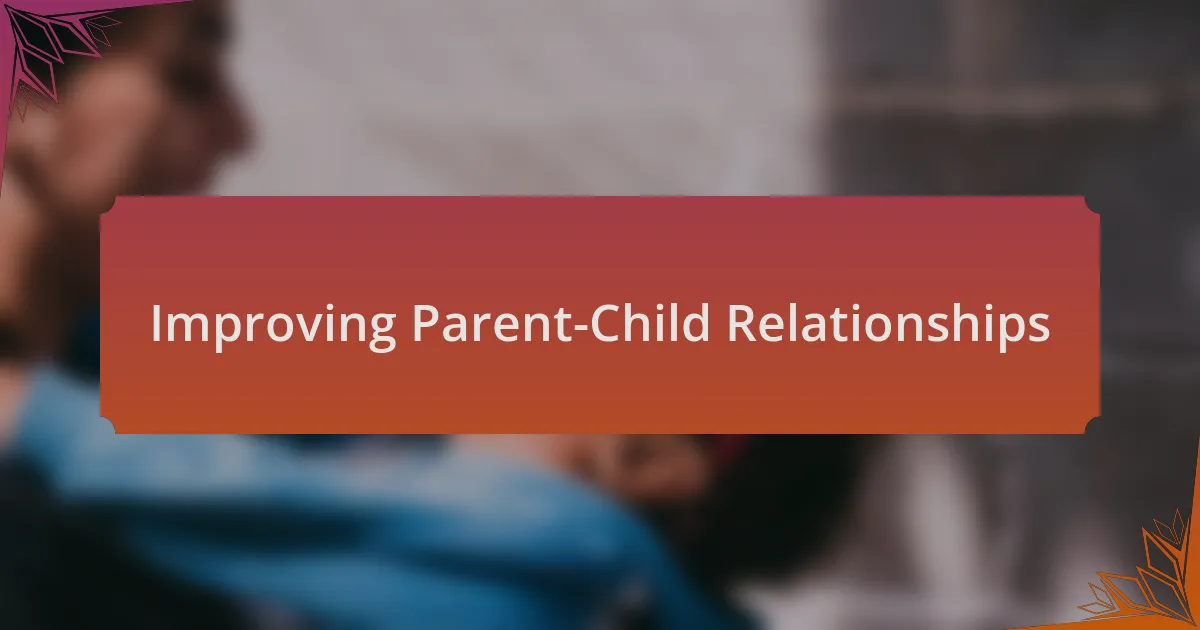
Improving Parent-Child Relationships
Building a strong relationship with my child often means embracing their emotional world, especially during tantrums. I vividly recall a time when my daughter, overwhelmed by her toys scattered everywhere, completely lost it. Instead of reacting with irritation, I sat down amidst the chaos and we talked it through. In that moment, I felt our bond strengthen, realizing that meeting her at her level of distress not only eased her feelings but also opened more channels of communication between us.
On another occasion, my son expressed his frustration over a missed playdate, leading to an emotional outburst that was hard to navigate. Instead of focusing on my annoyance, I asked him why he felt so upset. His response surprised me—it wasn’t just about missing fun; it was rooted in feeling lonely. Asking open-ended questions deepened our connection. How often do we, as parents, overlook these chances to understand our kids more profoundly?
Being present during these challenging times has taught me that vulnerability can bridge the gap between parent and child. One evening, after a particularly tough day, my youngest threw a fit about bedtime. Instead of simply imposing rules, I shared my own bedtime struggles from childhood, creating a shared experience that made them feel understood. Isn’t it remarkable how these seemingly simple moments can transform our relationships into powerful connections?
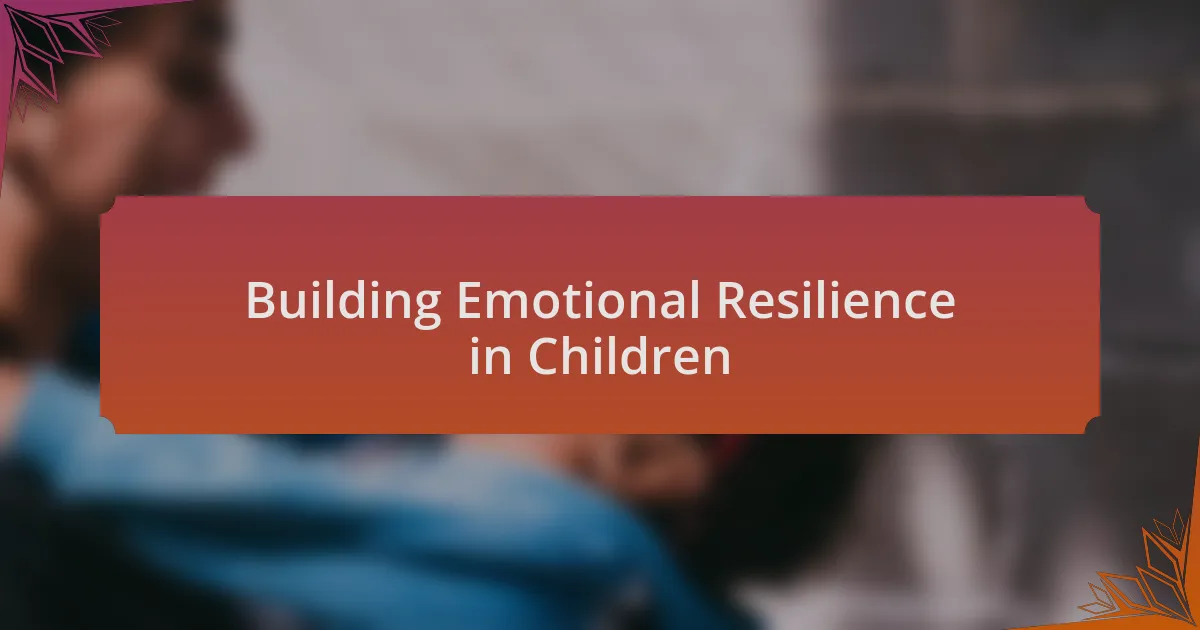
Building Emotional Resilience in Children
Building emotional resilience in children is a journey that often begins with how we respond to their distress. I remember a day when my son had a meltdown over a toy he couldn’t assemble. Instead of just stepping in and fixing it for him, I guided him through the process, asking questions that helped him articulate his frustration. I could see the lightbulb moment when he finally managed to fit the pieces together. Wasn’t it incredible to witness his pride? That experience solidified my belief that overcoming challenges can build a child’s confidence and emotional strength.
Another time, during a particularly trying week, my daughter had an overload of emotions after not receiving a school award she was aiming for. Rather than dismiss her feelings as just disappointment, I encouraged her to express what she was going through. We sat on her bedroom floor, and she shared how she felt “less than” her peers. I shared a story from my own childhood about a similar experience, and it was powerful—she realized she was not alone in her feelings. I often wonder if we, as parents, fully grasp the importance of these shared moments in helping our children develop resilience.
Finally, I’ve learned that teaching emotional resilience isn’t just about managing tantrums; it’s about modeling healthy emotional expression ourselves. I recall a time when I let my kids see me frustrated after a long day—a rare moment where I admitted my own struggle. Instead of hiding it, I explained my feelings and how I intended to cope. This openness encouraged them to express their emotions too. Isn’t it fascinating how our vulnerabilities can shine a light on their path to resilience? By acknowledging our struggles together, we’re building a foundation that can help them navigate their own emotions in a healthier way.